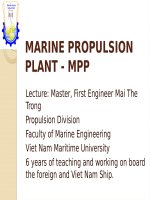BÀI GIẢNG TRANG TRÍ hệ ĐỘNG lực CHƯƠNG 4(ENGLISH)
Bạn đang xem bản rút gọn của tài liệu. Xem và tải ngay bản đầy đủ của tài liệu tại đây (229.01 KB, 51 trang )
Chapter 5
SYSTEM OF MARINE PROPULSION PLANT
Introduction
Marine propulsion plant is supported by many
systems. These systems have a closed relation to each
other. On board, they can be classified as follow:
Fuel oil system.
Lubricating oil system.
Cooling system.
Compressed air system.
Bilge system.
Ballast system.
Fire-water system.
Sanitary washing water system.
Ventilation system.
Air conditioner system.
5.1 Fuel oil system
I. Fuel for Diesel engine
Fuel for diesel engine is used in liquid form. Depending on
properties, fuel oil can be classified into two kinds: first one is
diesel oil (or DO) and other one is heavy fuel oil (or FO). They
are characterized by following properties.
1. Density
Density of fuel oil is ratio between specific gravity of fuel oil
(g/cm3) at standard condition (15 oC) and specific gravity of fresh
water at 4oC.
2. Viscosity at 50oC (cst)
Viscosity of fuel oil is unit for measure of resistance to flow of
fuel oil.
3. Water and sediment
These impurities are obviously not useful to diesel engine
operation. Water is the primary cause of corrosion in fuel
storage tanks and equipment especially cylinder liner. Sediment
causes a wear in plunger and clog filters, injection valve.
4. Flash point (oC)
The temperature at which the fuel oil vapors (formed
on surface of the fuel oil) can be burned by an open
flame.
5. Pour point (oC)
Pour point is the temperature at which fuel oil ceases
to flow.
6. Ash content (%)
Ash content of fuel oil is that material remaining after
fuel oil has been burned at a high temperature.
7. Carbon residue (%)
It is solid carbon left after fuel oil is burned with a
fixed amount of oxygen.
8. Sulfur content (%)
II. Function of fuel oil system
- To receive fuel oil into the ship.
- To store fuel oil in tanks.
- To transfer fuel oil between tanks.
- To clean fuel oil.
- To supply fuel for the main diesel engine,
diesel generators, aux. boiler.
- To indicate fuel oil level in tanks, fuel oil
consumption...
III. Requirements of the fuel oil system
1. General requirements of the fuel system:
- The system must ensure normal working of all
engines even when the ship rolling 15o and pitching
5o.
- Fuel pipe must not be arranged near exhaust pipe,
silencer, electric panel, and cabin or through fresh
water tanks.
- Fuel is normally stored in double bottom tanks or
wing tanks. Capacity of all tanks must be enough for
continuing operation of the ship in estimated time
with some percentage of fuel for stand by.
- There must be interconnection between tanks. The
valves should be arranged so that it is easy for
operation, checking and repairing.
- There must be separated pipes for receiving and
delivering fuel on each tank. Besides this, vent pipe,
drainpipe, overflow pipe (with sight glass), sounding
pipe (or sounding device), manhole for inspection and
repairing must be installed.
- Diameter of vent pipe is normally equal to receiving pipe.
The upper end of vent pipe is placed on upper deck with
a copper net to prevent dust and fire from falling into
fuel tanks. Diameter of vent pipe in any case must not
be smaller than 50 mm.
- The system must be provided with international flanges
for receiving and discharging pipe and placed on both
sides of the ship (Port & Starboard side).
- The system must be equipped with remote control device
for emergency shut down of delivery valves of each fuel
tank in case of fire or flooding in the engine room.
- There must be indicators, alarm devices such as: pressure
gauge, thermometer, viscometer, flow meter, and low-high
level alarm to increase the safety of the system.
- In case of using FO, FO purifier must be provided in the
system. FO must be heated in storage tanks, settling
tank, service tank before transferring and purifying.
Heating coil of the tanks should be arranged about 25 cm
from bottom of the tanks. If use steam for heating, steam
pressure must be smaller than 7 kg/cm2. Fuel pipe must
be heated and insulated to maintain FO temperature. The
heating temperature of FO before entering the engine
depends on kind of fuel and engine. This temperature can
be adjusted.
Figure 5.1: Fuel oil tank and fitting
3
1
4
7
6
8
9
2
5
1- Receiving pipe
2- Delivery pipe
3- Venting pipe
4- Overflow pipe
5- Drain valve
6- Thermometer
7- Level indicator
8- Heating coil
9- Manhole
DO fill line
DO store
DOtank
store
tank
FO fill line
DO service tank
DO purifier
FO settling
tank
FO service
tank
FO
purifier
FO heater
Figure 5.2: FO & DO purifier system of the marine engine practical room
2. Requirements of fuel injection system of diesel engine.
- Fuel must be injected to combustion chamber at proper
timing. The beginning time of injection in degrees of
crankshaft before top dead center must be the same for all
cylinders and can be adjusted.
- Amount of fuel delivered to each of the cylinders must be
the same.
- There must be a suitable rate and pressure of injection. The
fuel mass per degree of crankshaft travel must be the
same for all the fuel injection pumps.
- The fuel must be properly atomized.
- The fuel must be distributed over the volume of the
combustion chamber.
For auxiliary boiler, fuel sprayed into combustion chamber
must be in good atomization corresponding to the load of
boiler.
IV. The typical fuel oil system.
1. The typical diesel oil system (DO system).
DO system is used on small ships, for high-speed diesel engines
or generator engines. Because viscosity of DO is low, a heater of
DO is not required. However, DO may be heated before separating.
A diesel oil system is illustrated in Figure 5.3
2. The typical heavy fuel oil system (FO system).
FO system is mostly used on ships. When a heavy fuel oil system
is used, a diesel oil system is also required. This is called “a two
fuel system”. When the ship is in running up condition, FO is
used for the main engine. On the other hand, when the ship is
maneuvering, the main engine is switched over to DO.
Today, on some modern ships only FO is used. To maintain a
proper temperature of FO in the fuel injection valves, FO must be
continuously heated and circulated through the fuel injection
valves even when the engine is stopping.
DIESEL OIL
SYSTEM
2
3
14
8
12
7
9
10
11
6
5
1
4
15
13
1- Storage tank
2- Settling tank
3- Service tank
4- Sludge tank
5- Strainer
6- Transfer pump
7- Heater
8- Purifier
9- Rough filter
10- Supply pump
(Booster pump)
11- Fine filter
12- Fuel injection
pump
13- Fuel injection
valve
14- Pressure
regulating valve
15- Drain tank
From do trans. pump
1
Heavy fuel
oil system
From fo trans. pump
2
7
4
3
6
8
9
10
Aux. blr
9
12
13
8
14
11
12
5
15
16
17
M/e
1- DO settling tank
2- DO service tank
3- FO settling tank
4- FO service tank
5- Heater
6- DO purifier
7- FO purifier
8- Venting tank
9- Strainer
10- DO burner pump
11- FO burner pump
12- Flow meter
13- Rough filter
14- Supply pump
15- Circulating pump
16- Fine filter
17- Pressure regulating
valve
V. The main components of the fuel oil system.
A fuel oil system consists of following main components:
1. Fuel oil tanks: Storage tanks, settling tank, service tank,
dirty oil tank, spill oil tank (overflow tank), sludge tank.
2. Transfer pumps.
A transfer pump is used to transfer fuel oil between tanks
and supply fuel oil to the engines.
3. Fuel injection pumps.
They create a high pressure of fuel oil before supplying to
fuel injection valves.
4. Fuel injection valves.
Their duty is to atomize and distribute fuel oil over
combustion chambers of the engines.
5. Filters.
The are two kinds of filter in the system, they are rough
filter (strainer) and fine filter.
6. Heaters
Their function is to maintain proper viscosity of fuel oil.
Either electric heaters or steam heaters are used in
the system.
7. Purifiers.
They are used to separate water and sludge from fuel oil.
8. Pipe lines: Both high pressure and low-pressure pipes
are used in the system.
9. Indicators, alarm devices.
To serv. TK
Flowmeter
D/G K161
No1
F
FWT
To BLR
Oil return
DO TK
M/E 6NVD26 -A2
To BLR
Injection pump
FO
SERV
To serv. TK
D/G K161
No2
F
To FO
serv Tk
Heater
Fine
filter
LO TK
To FO
tank
To DO
tank
FO
SETTL
Mix tank
Trans. pump
Bunker
station
Figure 5.5:
Fuel oil
system of the
marine
engine
practical
room
5.3 COOLING SYSTEM
I. Functions of cooling system
1. Cooling diesel engine (ME and DG).
It reduces the temperature of the diesel engine parts
to the suitable temperatures. During the operation of
the diesel engine, the fuel-air mixture is burned in the
combustion chamber so its temperature is very high.
With such a high temperature, the parts of the diesel
engine (such as cylinders, cylinder covers, piston
crowns...) are heated. Therefore, these parts need to
be cooled to prevent cracking due to heat.
2. Cooling lubricating oil at the lubricating oil cooler.
While lubricating the working surfaces of the diesel
engine, the lubricating oil gets the heat that is created by
friction at the working surfaces so its temperature is raised
and its viscosity is reduced. This is not beneficial for the
diesel engine. That is why the lubricating oil must be
cooled.
3. Cooling supercharged air at the air cooler.
When compressed to a high pressure, the temperature of
the supercharged air is very high and its specific gravity is
decreased. So the supercharged air needs to be cooled
before entering to the cylinders. The purpose of this
cooling is to increase the mass of fresh air entering to the
cylinders.
4. Cooling other machinery: such as air
compressors, hydraulic oil system, stern tube and
stern bearings, intermediate bearings and thrust
bearing, condensers of provision refrigerating
system, air conditioner and auxiliary boiler...
Depending on the parts that are cooled, many
different kinds of cooling substance can be used
in the cooling system such as fresh water,
seawater, lubricating oil, and fuel oil;
Piston crowns may be cooled by water or
lubricating oil.
Fuel injection valves can be cooled by fresh water
or fuel oil.
Other parts almost are cooled by water (fresh
water or seawater).
II. Classification of cooling system.
There are two kinds of cooling system on the
ship. They are:
1. The open cooling system
2. losed cooling system.
In each type of cooling system, we will study
about:
It’s feature
Advantages
Disadvantages
1. The open cooling system
a. Feature:
•
Figure 5.8 is an illustration of an
system. In this system, seawater outside
taken in through the seachest valve and
cool the lubricating oil, the supercharged
engines, the compressors and so on.
•
After carrying out its duty, the seawater goes out to
overboard. In this case the seawater contacts directly
with the diesel engine and surfaces of the parts that need
to be cooled.
•
To regulate the seawater temperature in the system,
a three ways-valve is used. Three ways-valve can be set
in auto or manual mode.
open cooling
of the ship is
is pumped to
air, the diesel
b. Advantage
The system is simple and very cheap. The seawater is
available.
c. Disadvantages
- The seawater contains many scale components, so it is
easy to precipitate the scale on the cooling surfaces.
Because of this, it reduces ability of the heat exchange
therefore, the parts of the diesel engine cooled by the
seawater are easily cracked.
- Because the seawater contains many scale and salt, it
will cause erosion and electrolytic corrosion.
- The temperature of the sea water going out of the engine
is very low (It is limited to about 45 ÷ 50o C) this lead
to:
+ Thermal stress of the cylinders, cylinder covers and
piston crowns are very high.
+ Waste energy for cooling water is high.
+ The operators cannot reuse the thermal energy of the
cooling water.
- Effect of the cooling depends on the environment
condition that the ship is operating.
• 1- High sea
6
chest
• 2- Low sea
chest
• 3- Strainer
5
1
• 4- Cooling
seawater pump
4
• 5- Lubricating
2
3
To auxiliary machineries
oil cooler
• 6- Three-way
valve
FW CLR
D/G No1
K161
LO CLR
M/E
6NVD26 - A2
Air cooler
LO cooler
FW CLR
D/G No2
K161
FW cooler
LO CLR
To air compressor
To overboard
To overboard
To fire line
GS pump
Fire, ballast
& bilge pump
Strainer
From sea chest
2. The closed cooling system
a. Feature
•
Figure 5.10 illustrates a closed cooling system. In the closed
cooling system, both fresh and seawater are used.
•
•
•
•
The fresh water is pumped to cool the engine (such as
cylinders, cylinder covers...) and other auxiliary machinery such as
the air compressors... The fresh water going out of the engine at a
high temperature returns to the suction pipe of the fresh water
pump and then, it is cooled in the fresh water cooler before it is
pumped to the engine again and that makes a closed circuit.
The seawater is taken into the ship to cool the fresh water, the
lubricating oil, the supercharged air and other machinery and then
is discharged overboard
The temperature of the fresh water can be regulated by a
thermostatic control valve.
Steam generated in the system will go up to the expansion
tank. The fresh water in the system will be replenished from the
expansion tank to the suction pipe of the fresh water pump.









